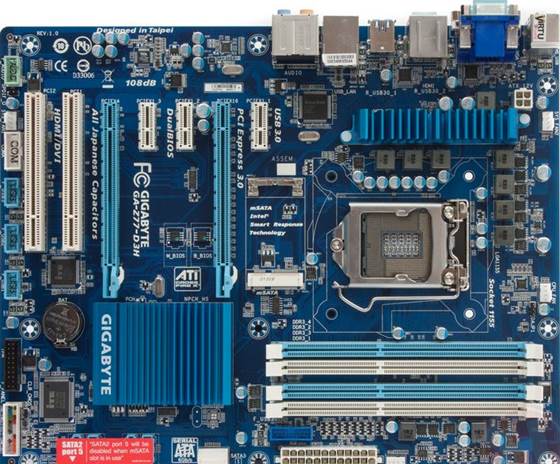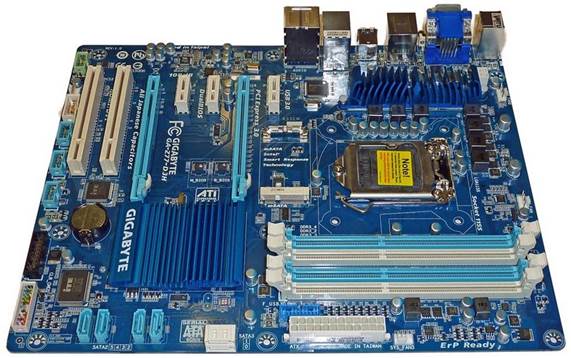The gigabyte Z77 – D3H is an intriguing
motherboard, as it uses a regular ATX form factor and is packed with features,
yet it costs a mere $123. Admittedly, you don't get much in the way of luxury,
so there are no micro buttons or POST debug display, and when you look closely
you'll see that although the chipset heat-sink is screwed down, the power
regulation heat sinks are secured by plastic pop pins.
I also noticed there is a four- pin ATX
12\/ connector, rather than the eight-pin block I might have expected to see.
I don't want to suggest that Gigabyte has
cut corners to keep costs to a minimum, because there are neat touches here and
there. Above the top graphics slot you'll find a mini SATA slot for an SSD
cache drive and the two SATA 6Gbps connectors are in line with the graphics
slot but are laid down for ease of connection.

The
gigabyte Z77 – D3H is an intriguing motherboard, as it uses a regular ATX form
factor and is packed with features, yet it costs a mere $123.
I mentioned the 'top graphics slot', but
this is a bit of an optical illusion, since the dual PCI Express slots are
actually PCI Express 3.0 x16 and PCI Express 2.0 x4 and they support CrossFireX
but not SLI. This seems like a curious use of the Z77 chipset and suggests you
should walk away if you want serious dual graphics card support.
That's pretty much the only fly in the
ointment, because you can use the PCI Express x4 slot for other expansion
duties or use the x1 slots, or you can fall back on the legacy PCI slots.
On the I/O panel there's full surround
sound audio, gigabit Ethernet, a set of HDMI, DVI-D and VGA outputs for the
graphics, two USB 2.0 ports and four USB 3.0 ports. That strikes me as a good
balance as we head towards the happy day when USB 2.0 is classed as legacy and
vanishes completely.
If you need more ports, there's a mid-board
USB 3.0 header and connections for six more USB 2.0 ports.

That's
pretty much the only fly in the ointment, because you can use the PCI Express
x4 slot for other expansion duties or use the x1 slots, or you can fall back on
the legacy PCI slots.
Navigating the UEFI dual- BIOS is a
pleasant experience although the mouse action lags slightly. The BIOS
recognized two XMP profiles for our Kingston memory and offered the choice of
1,600MHz and 2,133MHz, but the memory actually ran at 1,600MHz in Windows in
both cases. I manually increased the memory multiplier to give a speed of
2,400MHz and the Kingston RAM behaved properly, so I wonder whether this might
be an issue with the f19g beta BIOS rather than something more serious.
Increasing the CPU Turbo Boost in the BIOS
to run with a 4.5GHz limit raised performance by a useful 20% without the need
for any other changes to CPU voltage or raising the CPU TDP power limit beyond
77W.
That's not the only overclocking option,
because the Easy Tune6 utility has something to offer. There are three color
coded settings that are based on traffic lights. Green is 4.08GHz (102MHz base
clock), amber is 4.33GHz (103MHz base clock) and red is 4.58GHz (104MHz base
clock), which suggest respective clock multipliers of 40x, 42x and 44x.

That's
not the only overclocking option, because the Easy Tune6 utility has something
to offer.
I selected red and after the reboot that
allows the software to modify BIOS settings, I noted that the memory speed had
increased to 2200MHz. The system ran perfectly and the extra performance was
impressive.
This was especially joyous, as I have used
Easy Tune in the past and found it to be somewhat hit and miss. This version of
the software, on this motherboard with this CPU and memory, is flawless.

I
selected red and after the reboot that allows the software to modify BIOS
settings, I noted that the memory speed had increased to 2200MHz.
|
Details
·
Price: $123
·
Manufacturer: Gigabyte
·
Website: www.gigabyte.com
Ratings
·
Overall: 8
·
Quality: 9
·
Value: 8
|